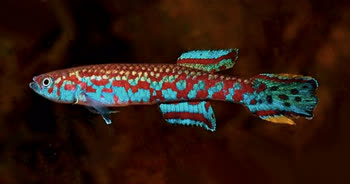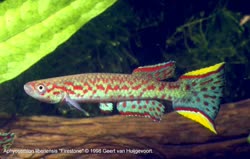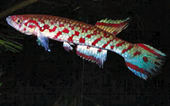ETYFISH writes: "In 1935 Ahl obtained fish from a commercial shipment identified as "Calabar" - the capital city of Cross River State, in Southern Nigeria, near the Cameroon border. "Kalabari", however, also refers to a specific tribe in the region. The Kalabari people are Ijaw speaking settlers that were originally fishermen before the coming of the Portuguese to the West African coastline. The Kalabari, like most Nigerian coastline tribes, traded with Europeans; there are some Ijaw who consider the Kalabari as a different ethnic group and vice versa. Historically Kalabari settlements have always been close to a river, because they believed their powers came from deities in the water.
 In 1935, the ichthyologist Ernst Ahl described under the name of “Aphyosemion calabaricus” fishes he had obtained in the commercial circuit and which had been presented as coming from "Calabar" in the area of the Niger delta. This fish was then reproduced and distributed to aquarists under the name of Aphyosemion calabaricum, and much later Roloffia calabarica. The breeding of killifish did not start in the 70’s as is often thought...
In 1935, the ichthyologist Ernst Ahl described under the name of “Aphyosemion calabaricus” fishes he had obtained in the commercial circuit and which had been presented as coming from "Calabar" in the area of the Niger delta. This fish was then reproduced and distributed to aquarists under the name of Aphyosemion calabaricum, and much later Roloffia calabarica. The breeding of killifish did not start in the 70’s as is often thought...
Robert Ellerman writes:
What few people know is that this fish - shown here in Dr. Walter Foersch's classic 1950's photo - is the oldest surviving, single source collection of a species of killifish - probably of any aquarium fish - in the hobby. It began its hobby existence as Aphyosemion calabaricum, then Roloffia calabarica, then Aphyosemion calabaricus and, finally, Scriptaphyosemion liberiensis "calabaricus". It was the first of the "Roloffias" imported into the hobby into Germany in 1935. Stunningly, that single collection survived...

 In 1935, the ichthyologist Ernst Ahl described under the name of “Aphyosemion calabaricus” fishes he had obtained in the commercial circuit and which had been presented as coming from "Calabar" in the area of the Niger delta. This fish was then reproduced and distributed to aquarists under the name of Aphyosemion calabaricum, and much later Roloffia calabarica. The breeding of killifish did not start in the 70’s as is often thought...
In 1935, the ichthyologist Ernst Ahl described under the name of “Aphyosemion calabaricus” fishes he had obtained in the commercial circuit and which had been presented as coming from "Calabar" in the area of the Niger delta. This fish was then reproduced and distributed to aquarists under the name of Aphyosemion calabaricum, and much later Roloffia calabarica. The breeding of killifish did not start in the 70’s as is often thought...



